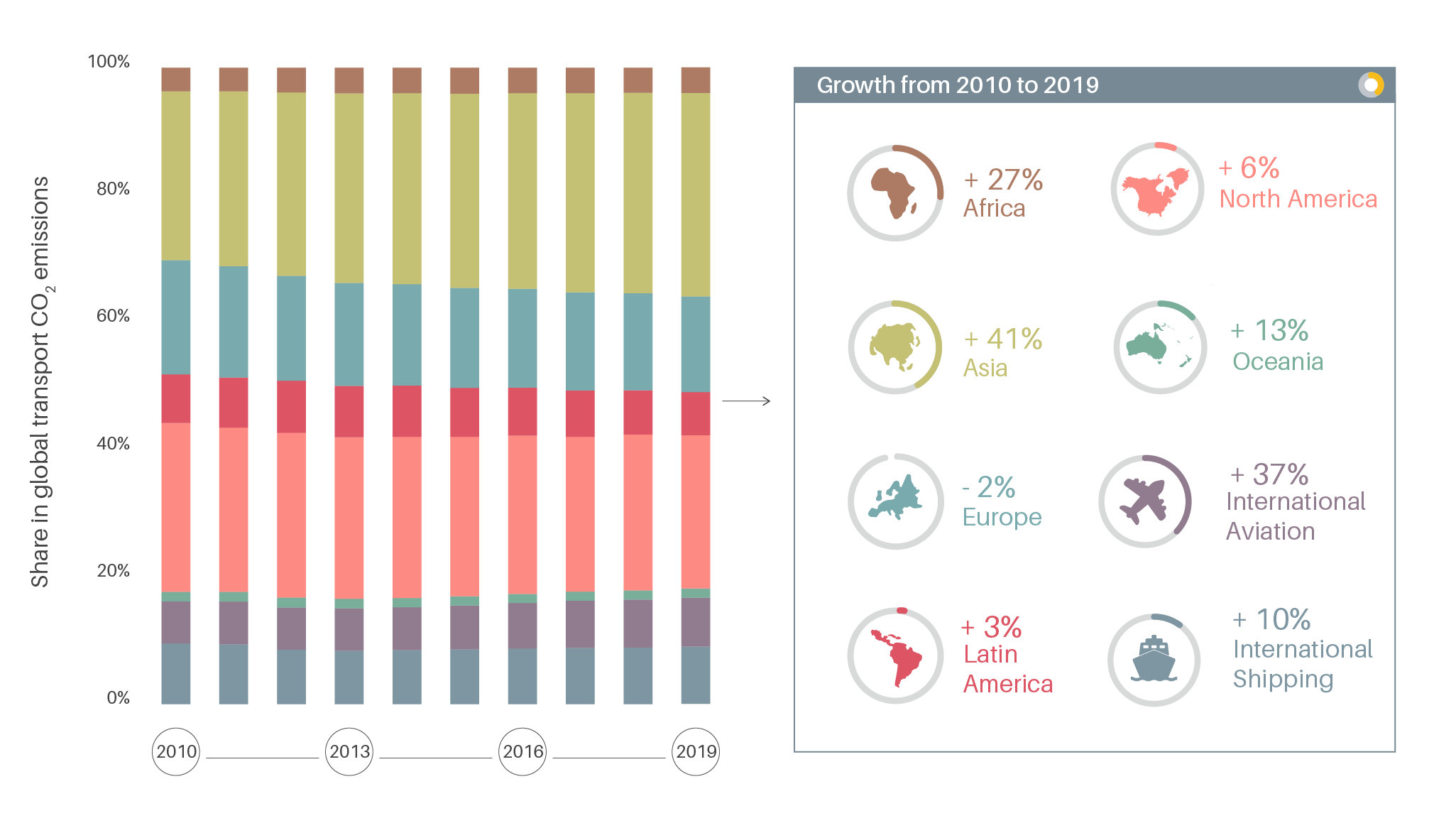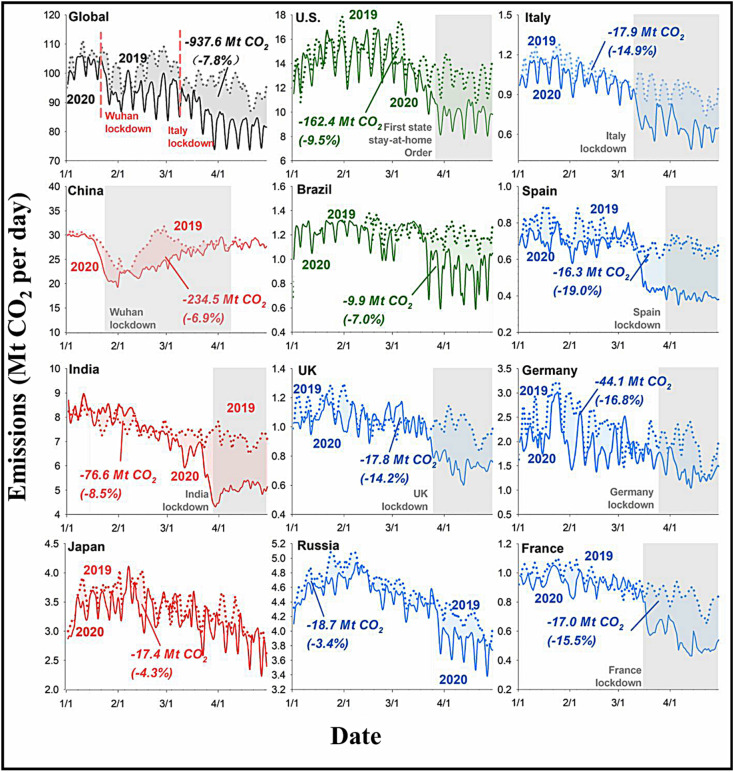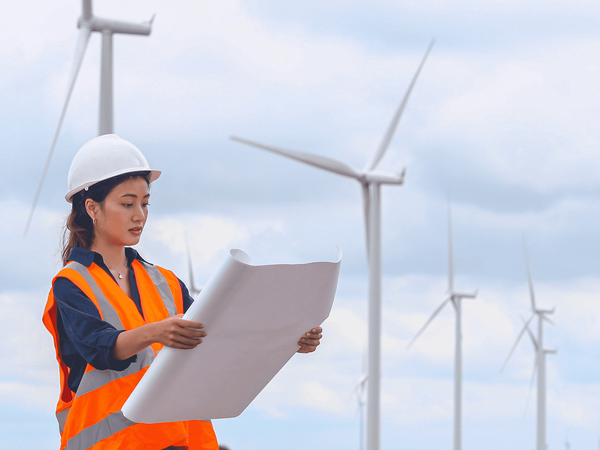Transportation emissions dropped due to COVID-19

A review on transport emissions
The beginning of 2020 saw countries going into lockdown due to the COVID-19 pandemic. As a result, the economy came to a standstill, companies that couldn’t do home office were shut down, and transportation was curtailed. However, as destructive as the COVID-19 was, there appeared a comforting outcome of a decrease in the global greenhouse gas (GHG) emissions.
Since industrialization began, the world has seen considerable economic growth, which has increased the demand for logistic services. In turn, the increased traffic volume has subsequently resulted in increased GHG emissions. Transport currently accounts for around one-fifth of global CO₂ emissions. The emissions from vehicles include air pollutants that contribute to smog, haze, and GHG, including CO2, NO2, and methane.
Figure 1 shows the global share of CO2 emissions in different continents from 2010 to 2019. As demonstrated, Africa, Asia, and Oceania recorded double-digit growth during these nine years, whereas there were 6% and 3% growth in North America and Latin America, respectively, and a 2% decrease in Europe.

Asia recorded the highest growth of 41% during this time. International aviation and shipping were also recorded, which showed the increase of 37% and 10%, respectively. The Asian Development Bank (ADB) stated that if no efforts are made to decrease the emissions in Asia, there will be a three- to five-fold increase in CO2 emissions from transportation by 2030 compared to emissions in 2000.
However, the trend changed with the spread of COVID-19, which notably reduced GHG emissions in the atmosphere. Some researchers studied the impact of COVID-19 for the full year in 2020, and found that the global GHG emissions decreased by 7.1% till 1st November. Furthermore, based only on emission data, a maximum reduction of 17% was recorded in April, which decreased to 12% in mid-June as the lockdowns were partially lifted in some countries.
According to SLOCAT, the CO2 emissions of transport sector in 2020 dropped by 19.4% compared to 2019 levels, with 56.4% decrease in international aviation, 31.9% in domestic aviation, 24.8% in international shipping and 14.6% in ground transport. The International Energy Agency (IEA) states that CO2 emissions from the global transportation sector decreased by more than 10% in 2020, i.e. 7.2 Gt. CO2, down from approximately 8.5 Gt. in 2019.
Before and after COVID-19
According to the IEA, global vehicle traffic decreased by nearly half in 2020 compared to the previous year. Figure 2 compares the data for the first four months from the pre-pandemic and pandemic scenarios globally (top left), as well as in the US, Italy, China, Brazil, Spain, India, the UK, Germany, Japan, Russia, and France. The dotted line is from 2019 and the solid line from 2020. In every studied country, the CO2 emission has decreased after the lockdown, compared to the previous year.

The World Meteorological Organization (WMO), on the other hand, claims that the worldwide reaction to the COVID-19 situation has had little impact on CO2 levels in the atmosphere.
Effects on air quality
There was also a noticeable difference in air quality. After the lockdown began on January 23, 2020, Wuhan city in China saw a nearly 63% decrease in NO2 with minor effects on SO2 and CO. PM10 levels in one of the most polluted cities in the world, New Delhi, have dropped by 44%, while PM2.5 levels decreased by 59%. Meanwhile, due to the lockdown on 23 March 2020, Southampton in the United Kingdom observed a 92% reduction in NO2 emissions compared to previous years.
Electric vehicles
Electric vehicles (EV) are popularly taken as a strategy to reduce GHG emissions produced by traffic. Developed countries are now supporting legislative measures aimed at increasing the use of EV. Due to the overwhelming purchasing of EV, emissions from new cars in the United Kingdom reached an all-time low in February 2022. The Guardian reported a relation between the emission and EV and stated that though only 12% of new sales were zero-exhaust EV, emissions fell by 11.2% in 2021.

The global EV stock from 2013 to 2020 is demonstrated in Figure 3. Even though most countries went into strict lockdown for few months in 2020, the EV’s ownership increased significantly compared to previous years— most of them owned in China.
The IEA’s Global EV Outlook 2021 finds that despite the pandemic destructed economic cascade, a record 3 million new electric cars were registered in 2020, a 41% increase from the previous year. The electric car sales reached 6.7 million in 2021, accounting for nearly 9% of worldwide car sale, and the number of EV on the road is expected to reach 145 million by 2030.
Without being under-sensitive to the destruction caused by COVID-19 globally, and as heartbreaking as the situation is, the current emissions result has provided an answer to ‘What we need to fight climate change properly?’. The considerable decrease in GHG emissions due to limited transport options during the pandemic suggests an immediate need for transformation to EV or alternative solutions to fossil-fuel-based vehicles.



